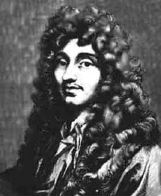

Christiaan Huygens came from an important Dutch family. His father was a diplomat. It was
through him that Christiaan was to gain access to the top scientific circles of the times.
Tutored at home by private teachers until he was 16 years old, Huygens learned geometry and how to make mechanical models and social skills such as
playing the lute. His mathematical education was clearly influenced by Descartes who was an occasional visitor at the Huygens' home, and took a great
interest in the mathematical progress of the young Christiaan.
Huygens studied law and mathematics at the University of Leiden and the College of Orange at Breda. Through his father's contact with Mersenne, a correspondence between Huygens and Mersenne began around this time. Mersenne challenged Huygens to solve a number of problems including the shape of the rope supported from its ends. Although he failed at this problem, he did solve the related problem of how to hang weights on the rope so that it hung in a parabolic shape. Huygens's first publications in 1651 and 1654 considered the fallacy in methods
proposed to square the circle.
Huygens soon turned his attention to lens grinding and telescope construction. Around 1654 he devised a new and better way of grinding and polishing
lenses. Using one of his own lenses, Huygens detected, in 1655, the first moon of Saturn. The following year he discovered the true shape of the rings of Saturn.
On a trip to Paris, Huygens learnt of the work on probability carried out in a correspondence
between Pascal and Fermat. On his return to Holland Huygens wrote a small work on the calculus of probabilities, the first printed work on the subject.
Work in astronomy required accurate timekeeping and this prompted Huygens to tackle this problem. In 1656, he patented the first pendulum clock, which
greatly increased the accuracy of time measurement. He built several pendulum clocks to determine longitude at sea. Huygens began to experiment with clocks regulated by springs, but their accuracy was poorer than his pendulum clocks.
Huygens derived the law of centrifugal force for uniform circular motion. As a result of this he, Hooke, Halley and Wren formulated the inverse-square law of gravitational
attraction. Huygens' work on the collision of elastic bodies showed the error of Descartes' laws of impact. Huygens also experimentally verified the law of conservation of momentum.
Huygens was elected to the Royal Society of London in 1663.
In 1673, published a book on physics. In it he solves the problem of the compound pendulum, describes the descent of bodies in a vacuum, defines evolutes and involutes of curves and,
after giving some elementary properties, finds the evolutes of the cycloid and of the parabola. Huygens attempts for the first time in this work to study the dynamics of bodies rather than particles. In a 1678 paper, Huygens argued in favor of a wave theory of light. He also worked on the velocity of light, which he believed was finite, and was pleased to hear of Römer's experiments which gave an approximate velocity for light determined by observing Jupiter's moons.
In 1689 he went to England, where he met Newton, Boyle and others in the Royal Society.
In the final years of his life Huygens composed one of the earliest discussions of extraterrestrial life, published after his death. He continued to work on improving lenses and on a spring regulated clock and on new pendulum clocks. Huygens also described the 31-tone equal temperament, which has led indirectly to a tradition of 31-tone music in the Netherlands in this century.
Huygens was the greatest mechanist of the seventeenth century. He combined Galileo's mathematical treatment of phenomena with Descartes' vision of the ultimate design of nature.